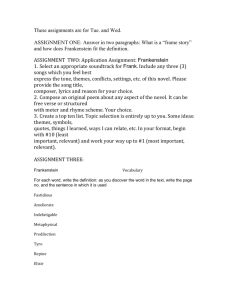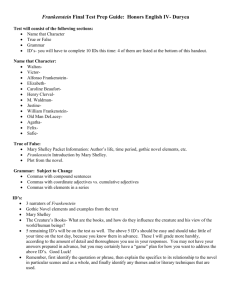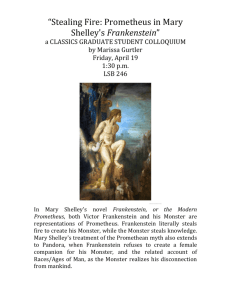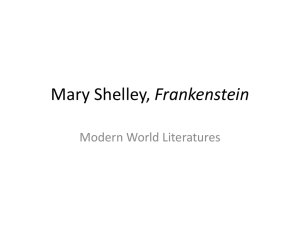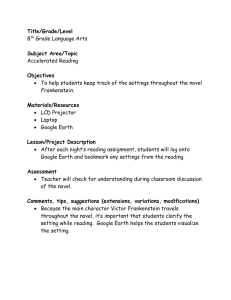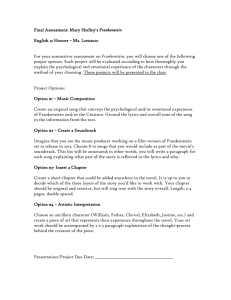Historical and Biographical Approaches:
advertisement
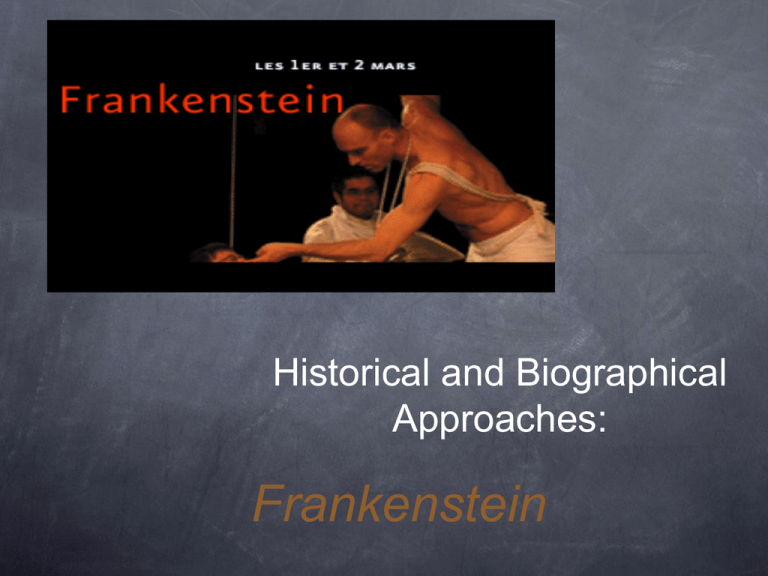
Historical and Biographical Approaches: Frankenstein “Frankenstein” Author: Mary Shelly Published in 1 Jan 1818 Original Name: “Frankenstein: The Modern Prometheus” Classic Gothic and Romanic Novel, with a concern to the “over-reaching” of scientism in the Industrial Revolution. Timeline 1818 Shelly is only 21! And these are the most advanced technologies !! So you can see how imaginative Shelly is Inspiration “How I, then a young girl, came to think of, and to dilate upon, so very hideous an idea? -Shelly During the snowy summer of 1816 (the eruption of Mount Tambora in 1815 had blocked the sky) Shelly visited Lord Byron In the visit, Byron challenged and John William Polidori (Byron’s physician) and Shelly to compose the scariest tale Shelly come up the idea of Frankenstein, Byron wrote a fragment based on the vampire legend he heard in the Balkans, from this Polidori later developed the novel “The Vampyre”. Thus, two of the most proliferated horror themes were created in the same contest! They both won! The unnaturalness and lifelessness of the “miniice age” after the eruption of Mt. Tambora also provided Shelly with the inspiration of the arctic setting in the novel. Victor Frankenstein To critics, Frankenstein is akin to some scientists of our own day, who attempt and achieve developments mostly because they have the technical ability to do so In this sense, Victor Frankenstein is surprisingly similar to another great inventor in history, Leonardo Da Vinci Leonardo Da Vinci used to sneak into crypts to dissect corpses to study them. Although he had expressed in his notes his abhorrence of war, he also designed some of the most advanced weapons in his time Frankenstein Many mistook the name Frankenstein as the monster’s name, the fact is the he was never named Instead he was called: 'creature', 'demon', 'fiend', and 'wretch' Victor, his creator and the real Frankenstein, called it: ‘Devil’, ‘Vile insect’, ‘Abhorred monster’, 'wretched devil' and 'abhorred devil' Victor Frankenstein and the monster Victor had regarded the monster as evil right from the start to the end, that’s strange in two ways First, he failed to see the eeriness of the monster all the time he was composing it Second, he also failed to consider his own responsibility and blamed everything on the monster Therefore, the common mistake might not be mistaken after all, for Victor Frankenstein can be seen as the true monster Historical Background of Frankenstein •Frankenstein Portrait of George III. He is widely remembered for two things: losing the American colonies and going mad. was published in the last years of the reign of George III. Its author, Mary Shelley, was born in 1797. Both the American and the French Revolutions were things of the past. •It must be admitted that the social and political picture in England during Mary Shelly’s years would have been enough to drive many sensitive and idealistic young people into radical thinking and action. Portrait of Mary Shelley “Dark satanic mills” were proliferating all over England •Enclosure Acts were driving small landowners, tenant farmers, and agricultural workers off their lands and into the slums of industrial cities; laborers everywhere endured horrible working conditions with no job security and faced the indifference and hostility of a new and growing capitalist class. The influences of her parents on Mary Shelley •Mary Wollstonecraft, the author of A Vindication of the Rights of Women (1792), and the novel The Wrongs of Woman, in which she wrote: "We cannot, without depraving our minds, endeavor to please a lover or husband, but in proportion as he pleases us." "Mary Wollstonecraft," by John Opie (circa 1797). The influences of her parents on Mary Shelley •Mary Portrait of William Godwin Shelley's father was the writer and political journalist William Godwin, who became famous with his work Political Justice (1793). Godwin had revolutionary attitudes to most social institutions. •Interestingly, few of these radical tendencies are evident in Frankenstein. Between the age of 15 and 17, Mary visited her middleclass friends in Dundee, where seems to give her a pleasant contrast to the polar opposite of her normal milieu. The 1st edition of Frankenstein in 1831. Mary Shelley used the Frankenstein and Clerval families in her novel to hearken back to Baxters. Biographical Features in Frankenstein •Already The book cover of another edition of Frankenstein. interested in science in her early years, Mary Shelley shared with her husband’s fascination with the natural sciences. Hence, we read the detailed accounts of the creation of the monster in her novel. Biographical Features in Frankenstein •However, Frankenstein’s chemistry is, to quote James Rieger, “switchedon magic, souped-up alchemy, the electrification of Agrippa and Paracelsus…[H]e wants the forbidden…. He is a criminal magician who employs up-to-dates tools” (xxvii). Biographical Features in Frankenstein •Of course, to some extent, Mary Shelley is employing certain features of contemporary Gothic romances. But she departs from the stock formulas of the genre. One notable biographical detail may be found in the geography, topography, and climate of the settings of the novel. Picture of black mill factories in the 19th century Biographical Features in Frankenstein •Mary Shelley was more interested in creating an “arctic of the mind” than in describing glaciers and ice floes scientifically. She was intimately acquainted with both the terrain and climatic conditions in the Alpine regions where she and Percy Shelley lived. Biographical Features in Frankenstein Although “Frankenstein” is famous for being a horror novel, the world in the fiction was deeply ingrained with Shelly’s belief of conventional sexual morality and family piety E.g. The expectation of conventional marriage between Victor and his cousin Elizabeth Family bonding: Victor’s friend Clerval Different Frankensteins Robert De Niro Boris Karloff Other Frankensteins Frankenstein - The Musical Batman as Frankenstein Andy Warhols Modern Frankensteins Like all great literature masterpieces, “Frankenstein” was topical in its era yet also contains something universal in time It questions human’s unending search for technical advancement and power, especially in the age of science Victor Frankenstein represents the part of human beings that are capable of unlimited ingenuity, yet are often found lacking in being responsible for the things we created In our own day, those who express great caution about human cloning need not base that caution on religious grounds alone As Shelly has shown though Victor Frankenstein, the inability to be responsible for one’s creation may present the greatest evil of all. “If researches manage to create living cells from scratch . . . . Scientists are close enough to create life in the lab that is time to start a public debate about what that would mean - for traditional views of the sanctity of life as well as for whether the creators will be able to control their creations” From “Researchers Exploring, ‘What is Life?’ Seek to Create a Living Cell”, Wall Street Journal Related Sources and Links about Frankenstein Mary Shelley http://www.kirjasto.sci.fi/mshelley.htm Full e-text of Frankenstein 1.worldonline.nl/~hamberg/ http://home- Fred Botting, ed. Frankenstein: Mary Shelley. New York :St. Martin's Press, 1995.

